Heavy Metal Concentration Estimation for Different Farmland Soils Based on Projection Pursuit and LightGBM with Hyperspectral Images
Abstract
1. Introduction
2. Materials and Methods
2.1. Study Area
2.2. Datasets
2.2.1. Soil Sample Collection and Analysis
2.2.2. Remote Sensing Data Preprocessing
2.3. Methods
Projection Pursuit Method
2.4. Model Evaluation Methods
2.4.1. Light Gradient Boosting Machine
2.4.2. Model Evaluation and Accuracy Verification
3. Results
3.1. Soil Heavy Metal Concentration Analysis
3.2. Spectral Characteristic Analysis of the Different Soils
3.3. Spectral Feature Selection
3.4. Model Construction and Evaluation
3.5. Soil Heavy Metal Concentration Mapping
4. Discussion
4.1. Performance Analysis of PP–LightGBM Model Estimation
4.2. Analysis of Heavy Metal Estimation Results in Different Soils
4.3. Uncertainty Analysis of Heavy Metal Concentration Estimation for Different Soils
5. Conclusions
Author Contributions
Funding
Institutional Review Board Statement
Informed Consent Statement
Data Availability Statement
Acknowledgments
Conflicts of Interest
References
- Hartemink, A.E. The Definition of Soil Since the Early 1800s. In Advances in Agronomy; Sparks, D.L., Ed.; Elsevier: Amsterdam, The Netherlands, 2016; Volume 137, pp. 73–126. [Google Scholar]
- Lwin, C.S.; Seo, B.-H.; Kim, H.-U.; Owens, G.; Kim, K.-R. Application of soil amendments to contaminated soils for heavy metal immobilization and improved soil quality-a critical review. Soil Sci. Plant Nutr. 2018, 64, 156–167. [Google Scholar] [CrossRef]
- Khan, S.; Cao, Q.; Zheng, Y.M.; Huang, Y.Z.; Zhu, Y.G. Health risks of heavy metals in contaminated soils and food crops irrigated with wastewater in Beijing, China. Environ. Pollut. 2008, 152, 686–692. [Google Scholar] [CrossRef]
- Shi, T.; Chen, Y.; Liu, Y.; Wu, G. Visible and near-infrared reflectance spectroscopy-An alternative for monitoring soil contamination by heavy metals. J. Hazard. Mater. 2014, 265, 166–176. [Google Scholar] [CrossRef]
- Wang, F.; Gao, J.; Zha, Y. Hyperspectral sensing of heavy metals in soil and vegetation: Feasibility and challenges. Isprs J. Photogramm. Remote Sens. 2018, 136, 73–84. [Google Scholar] [CrossRef]
- Zhuang, P.; McBride, M.B.; Xia, H.; Li, N.; Lia, Z. Health risk from heavy metals via consumption of food crops in the vicinity of Dabaoshan mine, South China. Sci. Total Environ. 2009, 407, 1551–1561. [Google Scholar] [CrossRef]
- Rehman, M.U.; Khan, R.; Khan, A.; Qamar, W.; Arafah, A.; Ahmad, A.; Ahmad, A.; Akhter, R.; Rinklebe, J.; Ahmad, P. Fate of arsenic in living systems: Implications for sustainable and safe food chains. J. Hazard. Mater. 2021, 417, 126050. [Google Scholar] [CrossRef]
- Adrees, M.; Ali, S.; Rizwan, M.; Ibrahim, M.; Abbas, F.; Farid, M.; Zia-ur-Rehman, M.; Irshad, M.K.; Bharwana, S.A. The effect of excess copper on growth and physiology of important food crops: A review. Environ. Sci. Pollut. Res. 2015, 22, 8148–8162. [Google Scholar] [CrossRef]
- Kumar, V.; Pandita, S.; Sidhu, G.P.S.; Sharma, A.; Khanna, K.; Kaur, P.; Bali, A.S.; Setia, R. Copper bioavailability, uptake, toxicity and tolerance in plants: A comprehensive review. Chemosphere 2021, 262, 127810. [Google Scholar] [CrossRef]
- Huicong, C.; Jinda, W.; Xuelin, Z. Study on arsenic content and its affecting factors in black soil of Yushu City of Jilin Province. J. Jilin Agric. Univ. 2007, 29, 83–85. [Google Scholar] [CrossRef]
- Yu, R.; Wang, Y.; Wang, C. Survey of heavy metal pollution and source identification of black soil in Zea mays L. cultivated region of Yushu city. Ecol. Environ. Sci. 2017, 26, 1788–1794. [Google Scholar] [CrossRef]
- Niu, L.; Yang, F.; Xu, C.; Yang, H.; Liu, W. Status of metal accumulation in farmland soils across China: From distribution to risk assessment. Environ. Pollut. 2013, 176, 55–62. [Google Scholar] [CrossRef] [PubMed]
- Xie, Y.; Chen, T.-B.; Lei, M.; Yang, J.; Guo, Q.-J.; Song, B.; Zhou, X.-Y. Spatial distribution of soil heavy metal pollution estimated by different interpolation methods: Accuracy and uncertainty analysis. Chemosphere 2011, 82, 468–476. [Google Scholar] [CrossRef] [PubMed]
- Sollitto, D.; Romic, M.; Castrignano, A.; Romic, D.; Bakic, H. Assessing heavy metal contamination in soils of the Zagreb region (Northwest Croatia) using multivariate geostatistics. Catena 2010, 80, 182–194. [Google Scholar] [CrossRef]
- Gholizadeh, A.; Saberioon, M.; Ben-Dor, E.; Boruvka, L. Monitoring of selected soil contaminants using proximal and remote sensing techniques: Background, state-of-the-art and future perspectives. Crit. Rev. Environ. Sci. Technol. 2018, 48, 243–278. [Google Scholar] [CrossRef]
- Liu, Z.; Lu, Y.; Peng, Y.; Zhao, L.; Wang, G.; Hu, Y. Estimation of Soil Heavy Metal Content Using Hyperspectral Data. Remote Sens. 2019, 11, 1464. [Google Scholar] [CrossRef]
- Sun, W.; Zhang, X. Estimating soil zinc concentrations using reflectance spectroscopy. Int. J. Appl. Earth Obs. Geoinf. 2017, 58, 126–133. [Google Scholar] [CrossRef]
- Liu, H.; Zhang, Y.; Zhang, B. Novel hyperspectral reflectance models for estimating black-soil organic matter in Northeast China. Environ. Monit. Assess. 2009, 154, 147–154. [Google Scholar] [CrossRef] [PubMed]
- Liu, M.; Liu, X.; Wu, M.; Li, L.; Xiu, L. Integrating spectral indices with environmental parameters for estimating heavy metal concentrations in rice using a dynamic fuzzy neural-network model. Comput. Geosci. 2011, 37, 1642–1652. [Google Scholar] [CrossRef]
- Lin, N.; Jiang, R.; Li, G.; Yang, Q.; Li, D.; Yang, X. Estimating the heavy metal contents in farmland soil from hyperspectral images based on Stacked AdaBoost ensemble learning. Ecol. Indic. 2022, 143, 109330. [Google Scholar] [CrossRef]
- Wei, L.; Pu, H.; Wang, Z.; Yuan, Z.; Yan, X.; Cao, L. Estimation of Soil Arsenic Content with Hyperspectral Remote Sensing. Sensors 2020, 20, 4056. [Google Scholar] [CrossRef]
- Liu, K.; Zhao, D.; Fang, J.-Y.; Zhang, X.; Zhang, Q.-Y.; Li, X.-K. Estimation of Heavy-Metal Contamination in Soil Using Remote Sensing Spectroscopy and a Statistical Approach. J. Indian Soc. Remote Sens. 2017, 45, 805–813. [Google Scholar] [CrossRef]
- Shi, S.; Hou, M.; Gu, Z.; Jiang, C.; Zhang, W.; Hou, M.; Li, C.; Xi, Z. Estimation of Heavy Metal Content in Soil Based on Machine Learning Models. Land 2022, 11, 1037. [Google Scholar] [CrossRef]
- Xu, X.; Ren, M.; Cao, J.; Wu, Q.; Liu, P.; Lv, J. Spectroscopic diagnosis of zinc contaminated soils based on competitive adaptive reweighted sampling algorithm and an improved support vector machine. Spectrosc. Lett. 2020, 53, 86–99. [Google Scholar] [CrossRef]
- Wang, S.; Chen, Y.; Wang, M.; Zhao, Y.; Li, J. SPA-Based Methods for the Quantitative Estimation of the Soil Salt Content in Saline-Alkali Land from Field Spectroscopy Data: A Case Study from the Yellow River Irrigation Regions. Remote Sens. 2019, 11, 967. [Google Scholar] [CrossRef]
- Zou, X.; Zhao, J.; Povey, M.J.W.; Holmes, M.; Mao, H. Variables selection methods in near-infrared spectroscopy. Anal. Chim. Acta 2010, 667, 14–32. [Google Scholar] [CrossRef] [PubMed]
- Jimenez, L.O.; Landgrebe, D.A. Hyperspectral data analysis and supervised feature reduction via projection pursuit. IEEE Trans. Geosci. Remote Sens. 1999, 37, 2653–2667. [Google Scholar] [CrossRef]
- Malpica, J.A.; Rejas, J.G.; Alonso, M.C. A projection pursuit algorithm for anomaly detection in hyperspectral imagery. Pattern Recognit. 2008, 41, 3313–3327. [Google Scholar] [CrossRef]
- Wang, Y.; Niu, R.; Hao, M.; Lin, G.; Xiao, Y.; Zhang, H.; Fu, B. A method for heavy metal estimation in mining regions based on SMA-PCC-RF and reflectance spectroscopy. Ecol. Indic. 2023, 154, 110476. [Google Scholar] [CrossRef]
- Huang, Y.; Lin, J.; Lin, X.; Zheng, W. Quantitative analysis of Cr in soil based on variable selection coupled with multivariate regression using laser-induced breakdown spectroscopy. J. Anal. At. Spectrom. 2021, 36, 2553–2559. [Google Scholar] [CrossRef]
- Liu, N.; Zhao, G.; Liu, G. Coupling Square Wave Anodic Stripping Voltammetry with Support Vector Regression to Detect the Concentration of Lead in Soil under the Interference of Copper Accurately. Sensors 2020, 20, 6792. [Google Scholar] [CrossRef]
- Chen, Y.; Wu, W. Mapping mineral prospectivity using an extreme learning machine regression. Ore Geol. Rev. 2017, 80, 200–213. [Google Scholar] [CrossRef]
- Zhang, H.; Yin, S.; Chen, Y.; Shao, S.; Wu, J.; Fan, M.; Chen, F.; Gao, C. Machine learning-based source identification and spatial prediction of heavy metals in soil in a rapid urbanization area, eastern China. J. Clean. Prod. 2020, 273, 122858. [Google Scholar] [CrossRef]
- Liu, G.; Zhou, X.; Li, Q.; Shi, Y.; Guo, G.; Zhao, L.; Wang, J.; Su, Y.; Zhang, C. Spatial distribution prediction of soil As in a large-scale arsenic slag contaminated site based on an integrated model and multi-source environmental data. Environ. Pollut. 2020, 267, 115631. [Google Scholar] [CrossRef] [PubMed]
- Guan, Q.; Zhao, R.; Wang, F.; Pan, N.; Yang, L.; Song, N.; Xu, C.; Lin, J. Prediction of heavy metals in soils of an arid area based on multi-spectral data. J. Environ. Manag. 2019, 243, 137–143. [Google Scholar] [CrossRef] [PubMed]
- Chen, L.; Lai, J.; Tan, K.; Wang, X.; Chen, Y.; Ding, J. Development of a soil heavy metal estimation method based on a spectral index: Combining fractional-order derivative pretreatment and the absorption mechanism. Sci. Total Environ. 2022, 813, 151882. [Google Scholar] [CrossRef]
- Zhou, W.; Yang, H.; Xie, L.; Li, H.; Huang, L.; Zhao, Y.; Yue, T. Hyperspectral inversion of soil heavy metals in Three-River Source Region based on random forest model. Catena 2021, 202, 105222. [Google Scholar] [CrossRef]
- Bhagat, S.K.; Tung, T.M.; Yaseen, Z.M. Heavy metal contamination prediction using ensemble model: Case study of Bay sedimentation, Australia. J. Hazard. Mater. 2021, 403, 123492. [Google Scholar] [CrossRef] [PubMed]
- Shehadeh, A.; Alshboul, O.; Al Mamlook, R.E.; Hamedat, O. Machine learning models for predicting the residual value of heavy construction equipment: An evaluation of modified decision tree, LightGBM, and XGBoost regression. Autom. Constr. 2021, 129, 103827. [Google Scholar] [CrossRef]
- Yan, J.; Xu, Y.; Cheng, Q.; Jiang, S.; Wang, Q.; Xiao, Y.; Ma, C.; Yan, J.; Wang, X. LightGBM: Accelerated genomically designed crop breeding through ensemble learning. Genome Biol. 2021, 22, 271. [Google Scholar] [CrossRef]
- Tan, K.; Ma, W.; Chen, L.; Wang, H.; Du, Q.; Du, P.; Yan, B.; Liu, R.; Li, H. Estimating the distribution trend of soil heavy metals in mining area from HyMap airborne hyperspectral imagery based on ensemble learning. J. Hazard. Mater. 2021, 401, 123288. [Google Scholar] [CrossRef]
- Wan, X.; Lei, M.; Yang, J. Two potential multi-metal hyperaccumulators found in four mining sites in Hunan Province, China. Catena 2017, 148, 67–73. [Google Scholar] [CrossRef]
- Benedet, L.; Faria, W.M.; Godinho Silva, S.H.; Mancini, M.; Melo Dematte, J.A.; Guimaraes Guilherme, L.R.; Curi, N. Soil texture prediction using portable X-ray fluorescence spectrometry and visible near-infrared diffuse reflectance spectroscopy. Geoderma 2020, 376, 114553. [Google Scholar] [CrossRef]
- Bao, Y.; Meng, X.; Ustin, S.; Wang, X.; Zhang, X.; Liu, H.; Tang, H. Vis-SWIR spectral prediction model for soil organic matter with different grouping strategies. Catena 2020, 195, 104703. [Google Scholar] [CrossRef]
- Xiao, S.; He, Y.; Dong, T.; Nie, P. Spectral Analysis and Sensitive Waveband Determination Based on Nitrogen Detection of Different Soil Types Using Near Infrared Sensors. Sensors 2018, 18, 523. [Google Scholar] [CrossRef] [PubMed]
- Shang, K.; Xiao, C.; Gan, F.; Wei, H.; Wang, C. Estimation of soil copper content in mining area using ZY1-02D satellite hyperspectral data. J. Appl. Remote Sens. 2021, 15, 042607. [Google Scholar] [CrossRef]
- Wu, M.; Dou, S.; Lin, N.; Jiang, R.; Zhu, B. Estimation and Mapping of Soil Organic Matter Content Using a Stacking Ensemble Learning Model Based on Hyperspectral Images. Remote Sens. 2023, 15, 4713. [Google Scholar] [CrossRef]
- Chiang, S.S.; Chang, C.I.; Ginsberg, I.W. Unsupervised target detection in hyperspectral images using projection pursuit. Ieee Trans. Geosci. Remote Sens. 2001, 39, 1380–1391. [Google Scholar] [CrossRef]
- Ifarraguerri, A.; Chang, C.I. Unsupervised hyperspectral image analysis with projection pursuit. IEEE Trans. Geosci. Remote Sens. 2000, 38, 2529–2538. [Google Scholar]
- Rufo, D.D.; Debelee, T.G.; Ibenthal, A.; Negera, W.G. Diagnosis of Diabetes Mellitus Using Gradient Boosting Machine (LightGBM). Diagnostics 2021, 11, 1714. [Google Scholar] [CrossRef]
- Hajihosseinlou, M.; Maghsoudi, A.; Ghezelbash, R. A Novel Scheme for Mapping of MVT-Type Pb-Zn Prospectivity: LightGBM, a Highly Efficient Gradient Boosting Decision Tree Machine Learning Algorithm. Nat. Resour. Res. 2023, 32, 2417–2438. [Google Scholar] [CrossRef]
- Fu, P.; Zhang, J.; Yuan, Z.; Feng, J.; Zhang, Y.; Meng, F.; Zhou, S. Estimating the Heavy Metal Contents in Entisols from a Mining Area Based on Improved Spectral Indices and Catboost. Sensors 2024, 24, 1492. [Google Scholar] [CrossRef] [PubMed]
- McCarty, D.A.; Kim, H.W.; Lee, H.K. Evaluation of Light Gradient Boosted Machine Learning Technique in Large Scale Land Use and Land Cover Classification. Environments 2020, 7, 84. [Google Scholar] [CrossRef]
- Bronick, C.J.; Lal, R. Soil structure and management: A review. Geoderma 2005, 124, 3–22. [Google Scholar] [CrossRef]
- Sipos, P.; Németh, T.; Mohai, I.; Dódony, I. Effect of soil composition on adsorption of lead as reflected by a study on a natural forest soil profile. Geoderma 2005, 124, 363–374. [Google Scholar] [CrossRef]
- Ying, S.C.; Kocar, B.D.; Fendorf, S. Oxidation and competitive retention of arsenic between iron- and manganese oxides. Geochim. Et Cosmochim. Acta 2012, 96, 294–303. [Google Scholar] [CrossRef]
- Xie, X.-L.; Pan, X.-Z.; Sun, B. Visible and Near-Infrared Diffuse Reflectance Spectroscopy for Prediction of Soil Properties near a Copper Smelter. Pedosphere 2012, 22, 351–366. [Google Scholar] [CrossRef]
- Peng, J.; Li, F.; Zhang, J.; Chen, Y.; Cao, T.; Tong, Z.; Liu, X.; Liang, X.; Zhao, X. Comprehensive assessment of heavy metals pollution of farmland soil and crops in Jilin Province. Environ. Geochem. Health 2020, 42, 4369–4383. [Google Scholar] [CrossRef]
- Domingo, J.L.; Nadal, M. Domestic waste composting facilities: A review of human health risks. Environ. Int. 2009, 35, 382–389. [Google Scholar] [CrossRef] [PubMed]
- Petropoulos, G.P.; Ireland, G.; Barrett, B. Surface soil moisture retrievals from remote sensing: Current status, products & future trends. Phys. Chem. Earth 2015, 83–84, 36–56. [Google Scholar] [CrossRef]
- Liu, H.-J.; Zhang, Y.-Z.; Zhang, X.-L.; Zhang, B.; Song, K.-S.; Wang, Z.-M.; Tang, N. Quantitative Analysis of Moisture Effect on Black Soil Reflectance. Pedosphere 2009, 19, 532–540. [Google Scholar] [CrossRef]
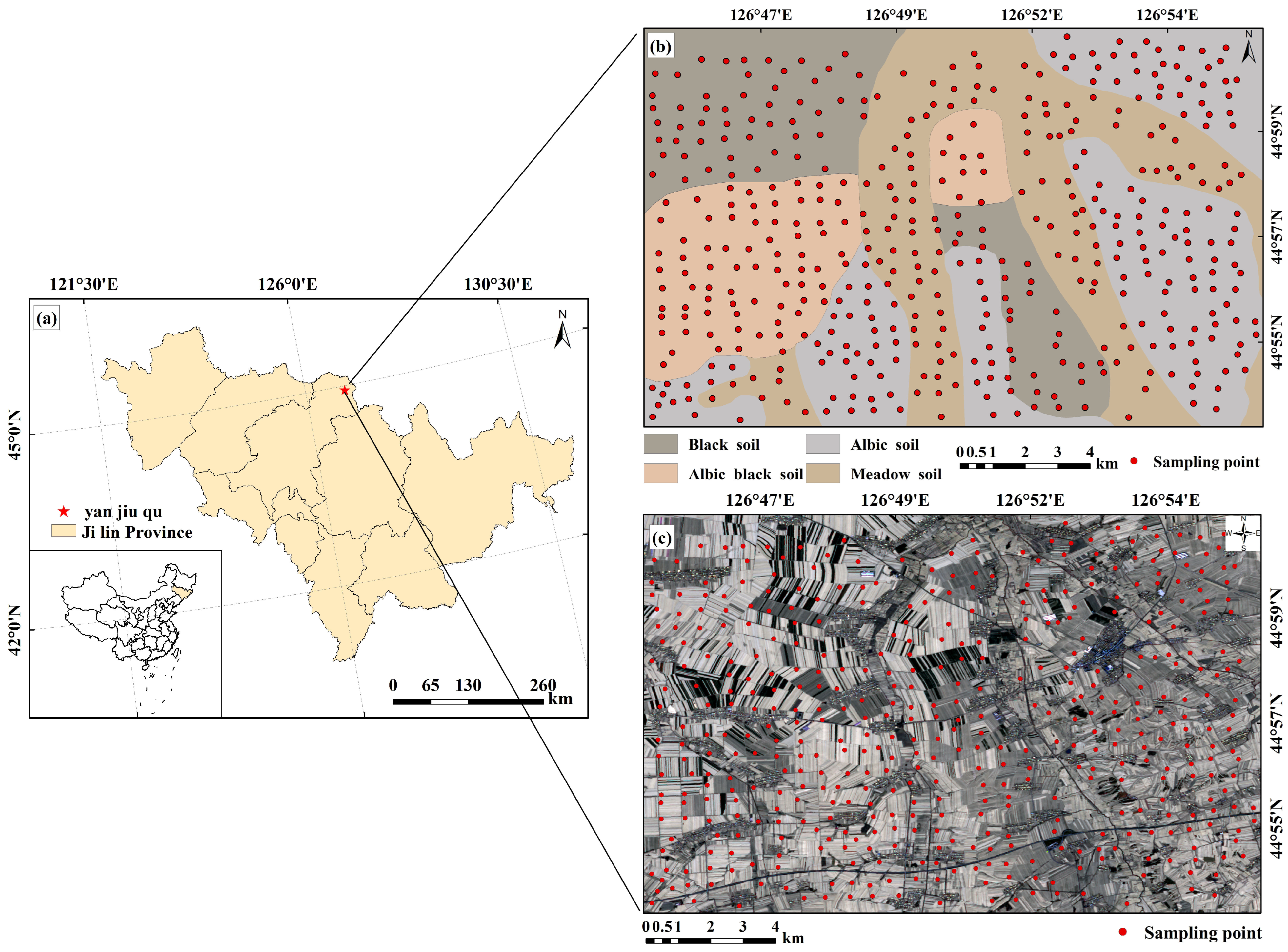



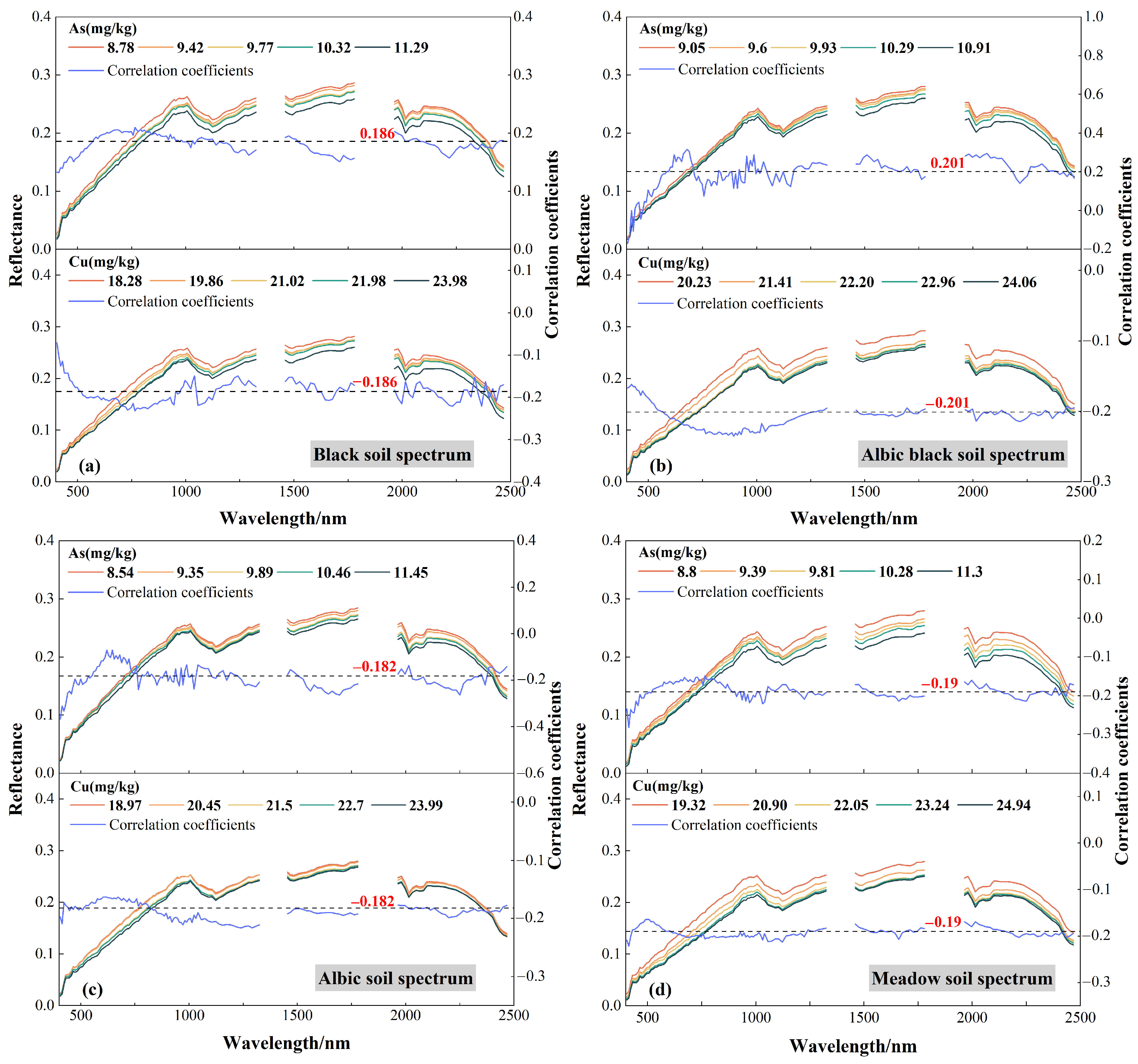
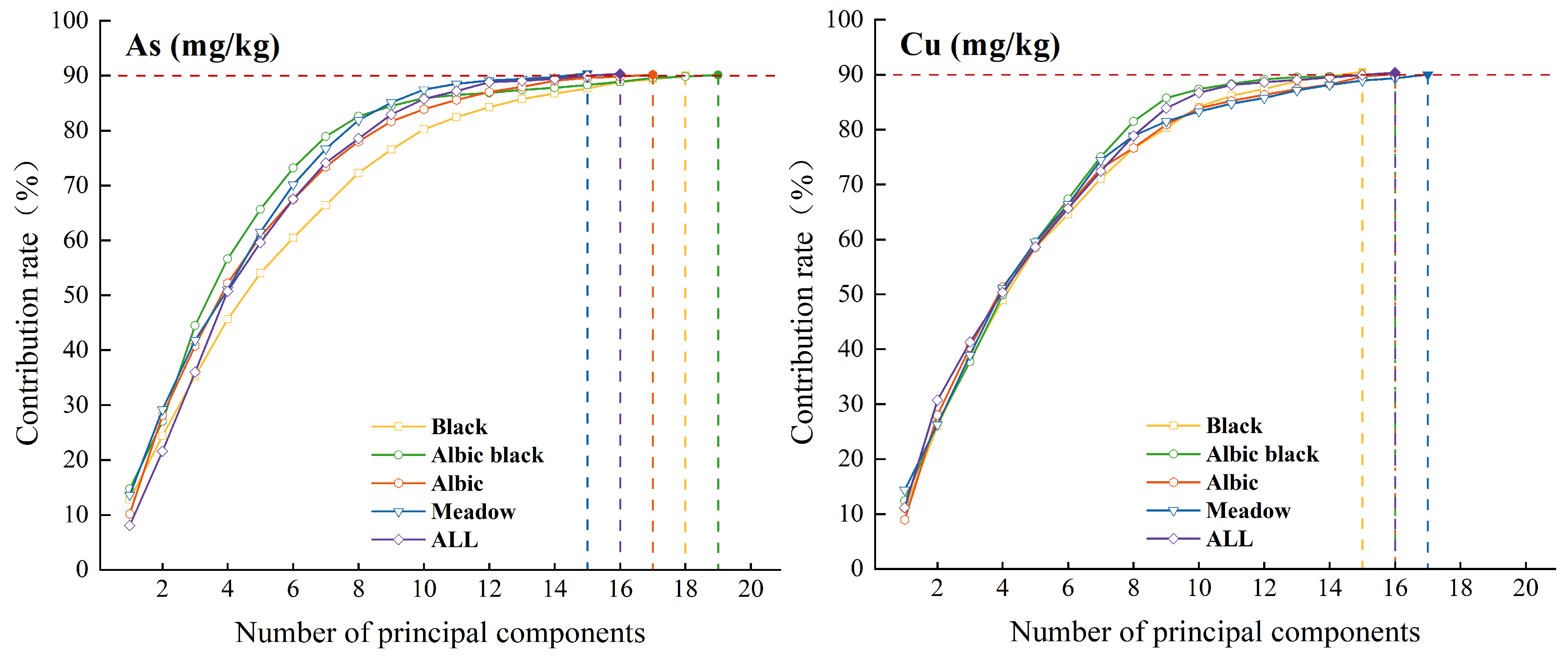

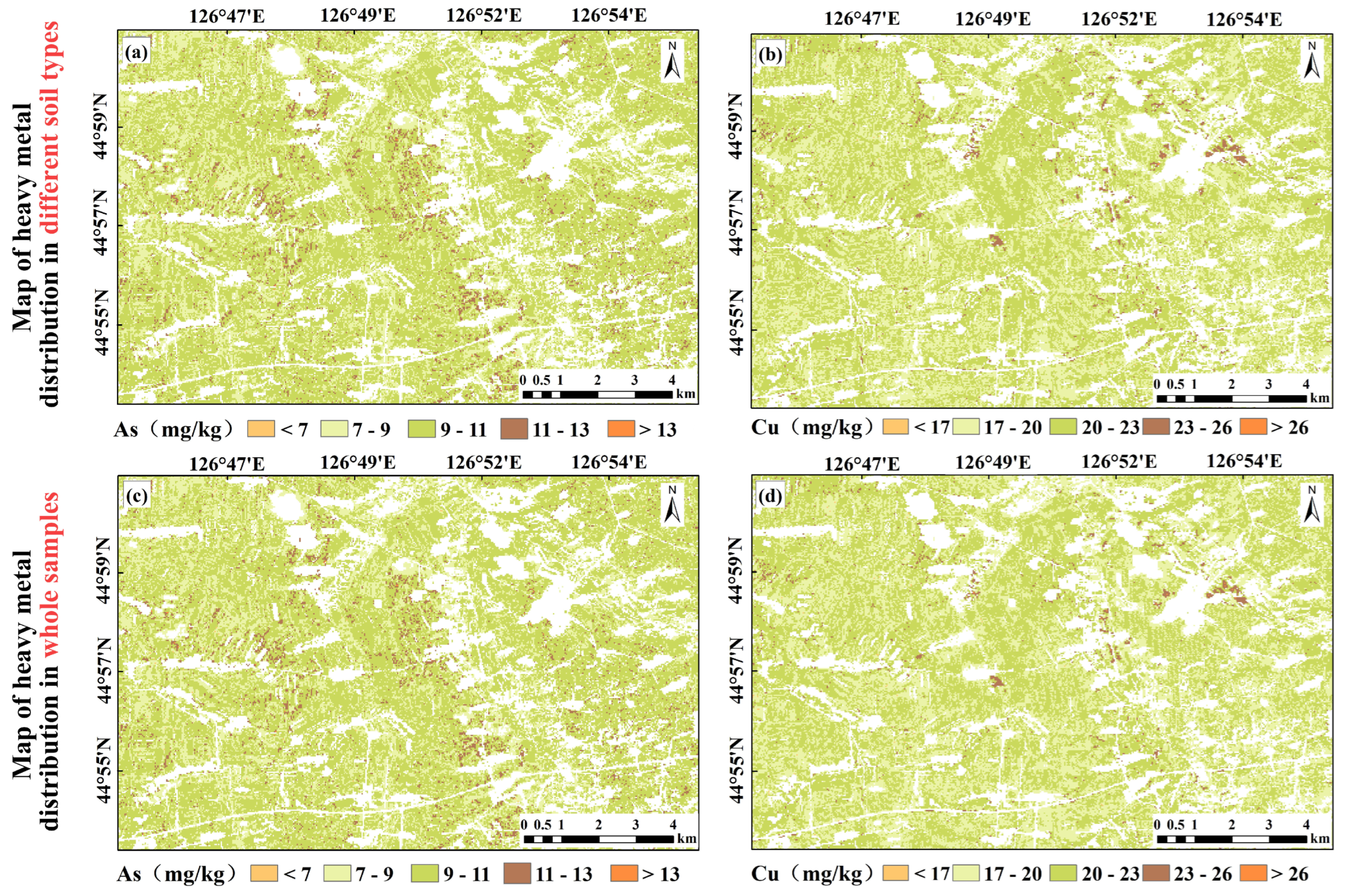


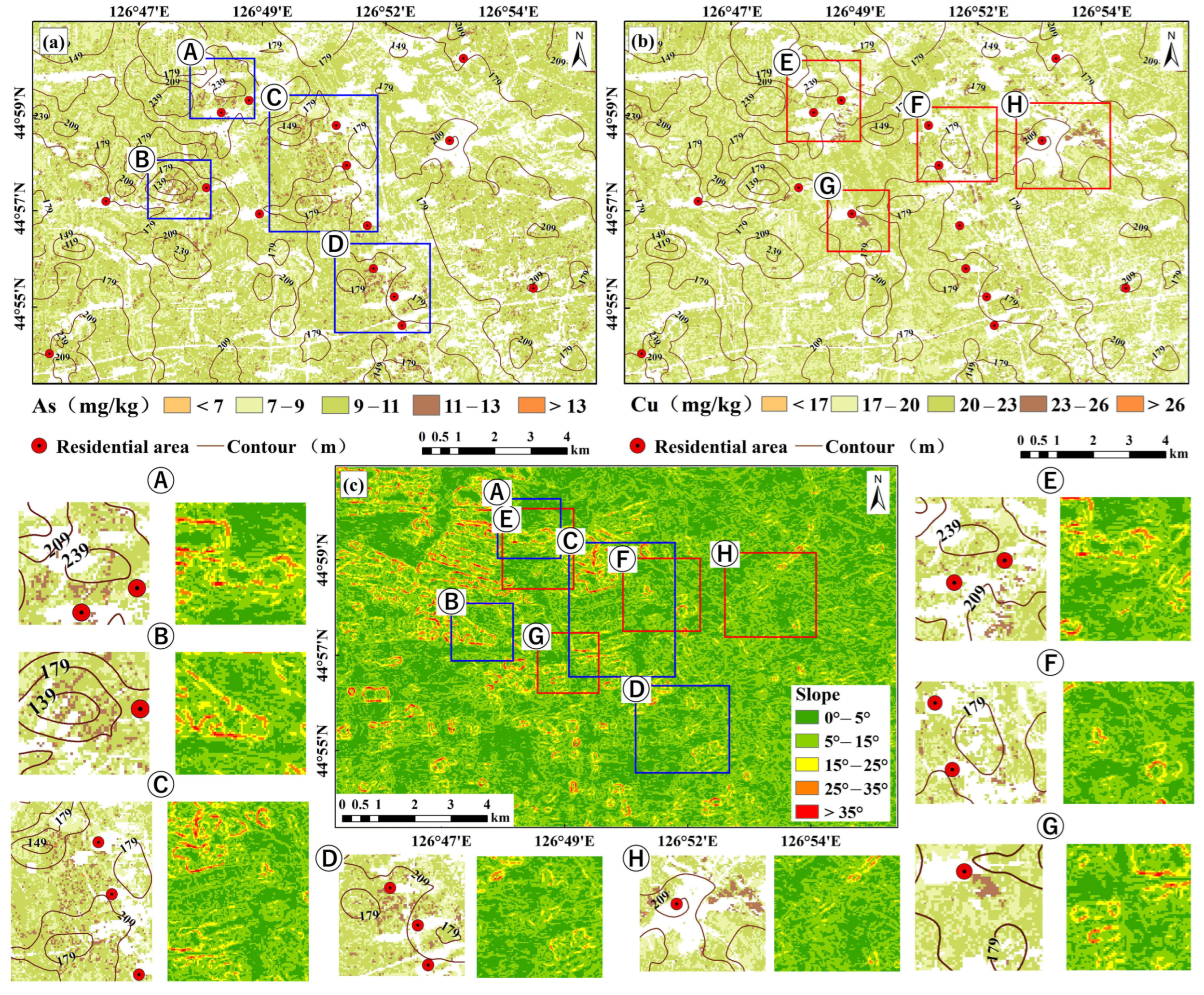
| Parameters | Value | Description |
|---|---|---|
| num_leaves | 31 | The most leaves that a tree can have |
| learning_rate | 0.05 | Improves learning rate |
| early_stopping_rounds | 50 | If the model loss does not drop in the specified rounds, the training will be stopped. |
| Element | Type | Max | Min | Mean | Std | CV | Background 1 | National 2 |
|---|---|---|---|---|---|---|---|---|
| As | Black | 11.63 | 8.16 | 9.93 | 0.67 | 0.067 | 6.70 | 15.00 |
| Albic Black | 13.14 | 7.24 | 9.95 | 0.93 | 0.094 | |||
| Albic | 12.82 | 7.32 | 9.94 | 1.06 | 0.106 | |||
| Meadow | 13.53 | 7.35 | 9.96 | 0.94 | 0.094 | |||
| Cu | Black | 29.51 | 17.52 | 22.17 | 1.91 | 0.144 | 16.40 | 35.00 |
| Albic Black | 26.86 | 16.76 | 21.56 | 2.06 | 0.098 | |||
| Albic | 25.37 | 19.14 | 21.05 | 1.36 | 0.061 | |||
| Meadow | 27.22 | 16.51 | 22.13 | 2.06 | 0.093 |
| Type | As | Cu | |
|---|---|---|---|
| Black | Maximum correlation coefficient | 0.209 | −0.232 |
| Corresponding band | 765 | 765 | |
| Number of sensitive bands | 65 | 81 | |
| Albic black | Maximum correlation coefficient | 0.317 | −0.226 |
| Corresponding band | 679 | 894 | |
| Number of sensitive bands | 75 | 94 | |
| Albic | Maximum correlation coefficient | −0.367 | −0.220 |
| Corresponding band | 404 | 1031 | |
| Number of sensitive bands | 84 | 92 | |
| Meadow | Maximum correlation coefficient | −0.282 | −0.222 |
| Corresponding band | 413 | 413 | |
| Number of sensitive bands | 65 | 91 |
| Elements | Type | Wavelength (nm) | Number of Principal Components | Cumulative Contribution (%) |
|---|---|---|---|---|
| As | Black | 885, 859, 988, 2048, 1040, 542, 765, 1543, 2317, 550, 1072, 413, 2400, 507, 1031, 1274, 524, 816 | 18 | 90.00 |
| Albic Black | 481, 1223, 1660, 1475, 593, 954, 885, 2014, 585, 490, 1728, 1173, 413, 2233, 679, 1526, 507, 455, 1745 | 19 | 90.11 | |
| Albic | 1963, 1492, 902, 404, 619, 705, 1576, 2266, 2132, 894, 499, 2283, 1207, 945, 713, 602, 516 | 17 | 90.18 | |
| Meadow | 696, 1274, 2148, 1745, 1677, 550, 2115, 636, 1526, 413, 1240, 2484, 2199, 516, 619 | 15 | 90.44 | |
| ALL | 679, 1778, 885, 404, 662, 455, 2334, 2081, 765, 1459, 868, 1492, 1257, 610, 1023, 413 | 16 | 90.33 | |
| Cu | Black | 928, 1963, 2334, 473, 851, 1031, 765, 499, 645, 2199, 1980, 2434, 1223, 1190, 653 | 15 | 90.50 |
| Albic Black | 2216, 774, 894, 490, 481, 902, 713, 1190, 876, 421, 2014, 653, 662, 687, 413, 1173 | 16 | 90.14 | |
| Albic | 542, 756, 1031, 842, 1475, 1644, 679, 1190, 791, 507, 1778, 2233, 2182, 765, 653, 2081 | 16 | 90.17 | |
| Meadow | 516, 945, 2417, 1207, 1745, 1526, 705, 619, 876, 413, 808, 1023, 499, 971, 1105, 2014, 774 | 17 | 90.03 | |
| ALL | 928, 670, 524, 765, 2366, 1324, 1627, 413, 1711, 894, 1610, 1728, 1644, 2199, 902, 937 | 16 | 90.37 |
| As | Cu | ||||||
|---|---|---|---|---|---|---|---|
| Type | Model | ||||||
| Black | PP-ELM | 0.64 | 0.62 | 1.51 | 0.61 | 1.27 | 1.50 |
| PP-GBDT | 0.68 | 0.60 | 1.56 | 0.66 | 1.21 | 1.58 | |
| PP–LightGBM | 0.73 | 0.54 | 1.73 | 0.75 | 1.12 | 1.72 | |
| Albic Black | PP-ELM | 0.55 | 0.48 | 1.40 | 0.60 | 0.93 | 1.47 |
| PP-GBDT | 0.63 | 0.45 | 1.49 | 0.63 | 0.89 | 1.53 | |
| PP–LightGBM | 0.70 | 0.42 | 1.60 | 0.72 | 0.82 | 1.66 | |
| Albic | PP-ELM | 0.56 | 0.75 | 1.41 | 0.58 | 1.43 | 1.44 |
| PP-GBDT | 0.62 | 0.72 | 1.47 | 0.62 | 1.36 | 1.51 | |
| PP–LightGBM | 0.68 | 0.68 | 1.56 | 0.69 | 1.25 | 1.64 | |
| Meadow | PP-ELM | 0.58 | 0.65 | 1.44 | 0.55 | 1.46 | 1.41 |
| PP-GBDT | 0.65 | 0.62 | 1.51 | 0.60 | 1.37 | 1.50 | |
| PP–LightGBM | 0.72 | 0.57 | 1.64 | 0.68 | 1.28 | 1.61 | |
| All | PP-ELM | 0.50 | 0.76 | 1.28 | 0.52 | 1.55 | 1.32 |
| PP-GBDT | 0.56 | 0.70 | 1.39 | 0.59 | 1.46 | 1.40 | |
| PP–LightGBM | 0.62 | 0.68 | 1.43 | 0.63 | 1.42 | 1.44 | |
Disclaimer/Publisher’s Note: The statements, opinions and data contained in all publications are solely those of the individual author(s) and contributor(s) and not of MDPI and/or the editor(s). MDPI and/or the editor(s) disclaim responsibility for any injury to people or property resulting from any ideas, methods, instructions or products referred to in the content. |
© 2024 by the authors. Licensee MDPI, Basel, Switzerland. This article is an open access article distributed under the terms and conditions of the Creative Commons Attribution (CC BY) license (https://creativecommons.org/licenses/by/4.0/).
Share and Cite
Lin, N.; Shao, X.; Wu, H.; Jiang, R.; Wu, M. Heavy Metal Concentration Estimation for Different Farmland Soils Based on Projection Pursuit and LightGBM with Hyperspectral Images. Sensors 2024, 24, 3251. https://doi.org/10.3390/s24103251
Lin N, Shao X, Wu H, Jiang R, Wu M. Heavy Metal Concentration Estimation for Different Farmland Soils Based on Projection Pursuit and LightGBM with Hyperspectral Images. Sensors. 2024; 24(10):3251. https://doi.org/10.3390/s24103251
Chicago/Turabian StyleLin, Nan, Xiaofan Shao, Huizhi Wu, Ranzhe Jiang, and Menghong Wu. 2024. "Heavy Metal Concentration Estimation for Different Farmland Soils Based on Projection Pursuit and LightGBM with Hyperspectral Images" Sensors 24, no. 10: 3251. https://doi.org/10.3390/s24103251
APA StyleLin, N., Shao, X., Wu, H., Jiang, R., & Wu, M. (2024). Heavy Metal Concentration Estimation for Different Farmland Soils Based on Projection Pursuit and LightGBM with Hyperspectral Images. Sensors, 24(10), 3251. https://doi.org/10.3390/s24103251





